Two large scale models of bronze chariots and horses came unearthed in December, 1980, about 20 meters (22 yards) west to the mound of
Qin Shi Huang Mausoleum. Tagged Bronze Chariot and Horses No. 1 and No. 2 respectively, they were originally encased in a wooden box which was buried 8 meters (26 feet) down in a trench for over two thousand years. Both required extensive restoration, before public display. No. 2 Chariot was unveiled first in 1983, then No.1 Chariot in 1988. Visitors can now appreciate them in Pits of Bronze Chariots at Emperor Qin Shi Huang's Mausoleum.
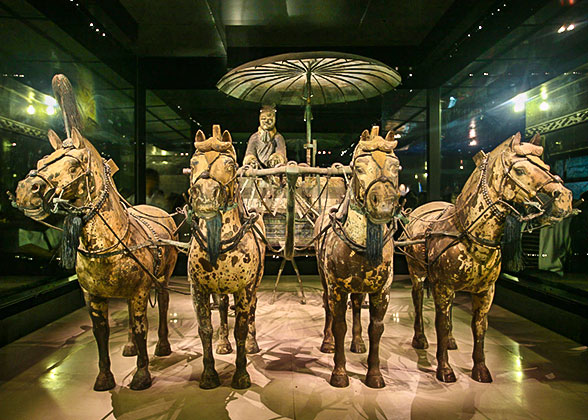 | | No.1 Bronze Chariot and Horses | | 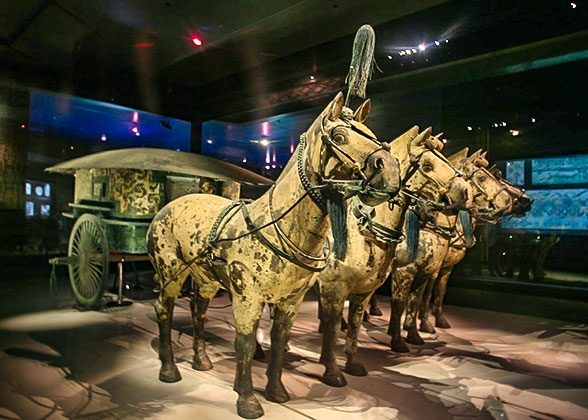 | | No.2 Bronze Chariot and Horses | |
Emperor Qin Shi Huang’s Vehicles in Afterlife
Intended to serve as the vehicles for the inspection tours of Emperor Qin Shi Huang in his afterlife, these two chariots and horses are half size scale models of the real ones of Qin Dynasty (221 – 207BC), faithfully copied down to the last detail, and each complete with a team of four strong horses and a coachman. You can also see coachmen armed with swords on both sides guarding the chariots. They were constructed in bronze and cast bullion, but beyond that there are plenty of gold and silver pieces, that weigh about 14 kilograms (30 pounds) in total. Decorated with geometric and cloud patterns, the two square carriages with a single shaft and two wheels were drawn beautifully in various colors, including red, violet, and blue. They are the earliest found, largest, and best-preserved bronze carriages to be found in China.
No. 1 Bronze Chariot and Horses
No. 1 Chariot is the vanguard. There is a large umbrella providing shade from the sun. Its handle is flexible and rotatable to block the sun from different angles, hence this umbrella is considered to be the world's earliest sunshade. A driver is standing below the umbrella, with his hands holding the horses’ rein. The entire No. 1 bronze carriage and horses are decorated with exquisite colored drawings, and gold and silver ornaments weighing over 3,000 and 4,000 grams (6.6 and 8.8 pounds) respectively.
Measurement: 225 cm long x 152 cam high (89 x 60 inches)
Weight: 1,061 kilograms (2,340 pounds)
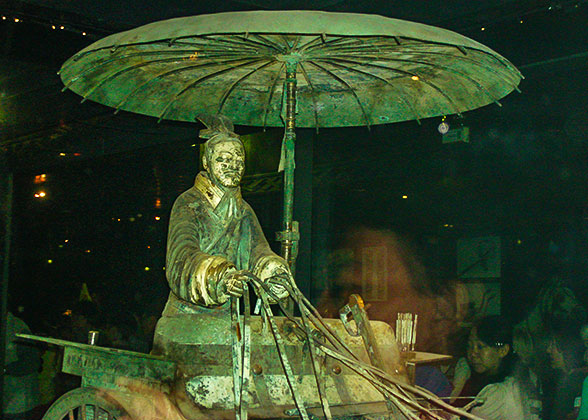 | | Coachman Statue | | 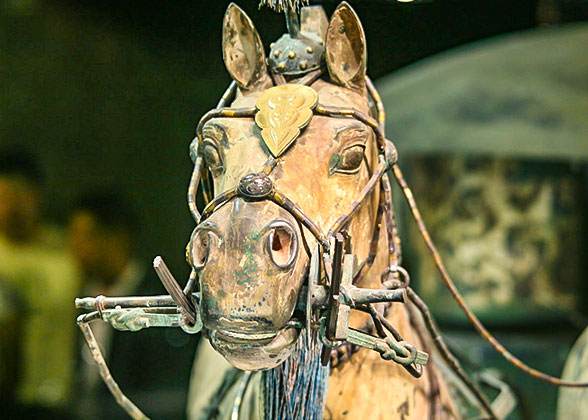 | | Bronze Horses Standing Side by Side | |
No. 2 Bronze Chariot and Horses
This is larger than the No. 1 Bronze Chariot and Horses and the chariot is enclosed. The horses are richly adorned with gold and silver trappings. The chariot has three windows, one to the front, and one on either side in the compartment, and a door opens at the back. One may open and close the windows and the door. The roof is umbrella shaped, said to be symbolic of the round sky. There is a kneeling figure driving the No. 2 bronze vehicle.
Measurement: 317 long x 106 high cm (125 x 42 inches)
Weight: 1,241 kilograms (2,736 pounds)
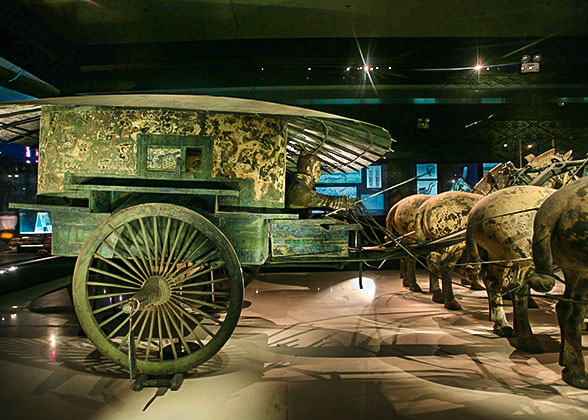 | | Side View of No.2 Bronze Chariot and Horses | | 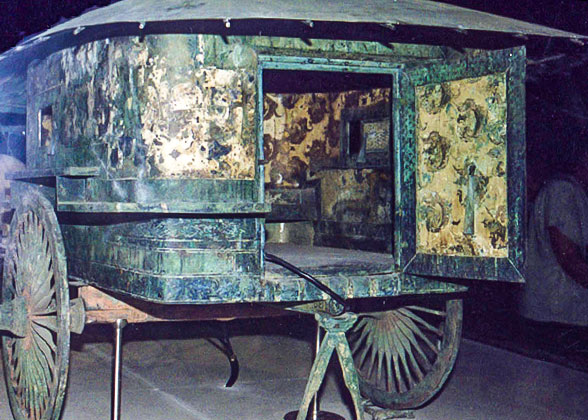 | | The door is on the back of the chariot. | |
Advanced Manufacturing Techniques
Qin artisans adopted great deal of superb crafts during the manufacture process, such as casting, soldering, and riveting. A total of more than 5,000 components and parts are used on the bronze chariots and horses, and each of them is complete and independent. It is innovative that the craftsmen split the complex components into simple parts, and they manufactured the simple ones separately and assembled them into a complex whole. For example, the horse’s headstall is fabricated with 82 and 78 tiny gold and silver tubes, which are flat and only 0.8 centimeters (0.3 inches) long.
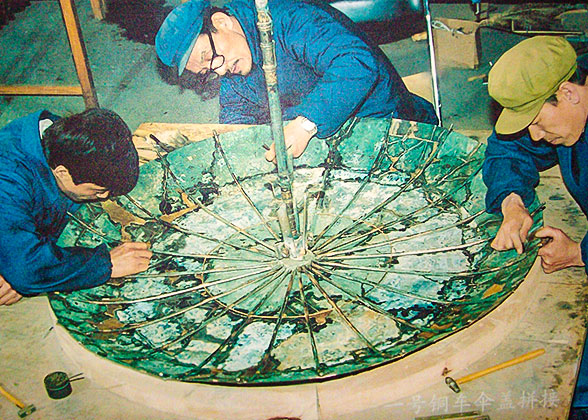 | | The Umbrella of the Chariot under Repair | | 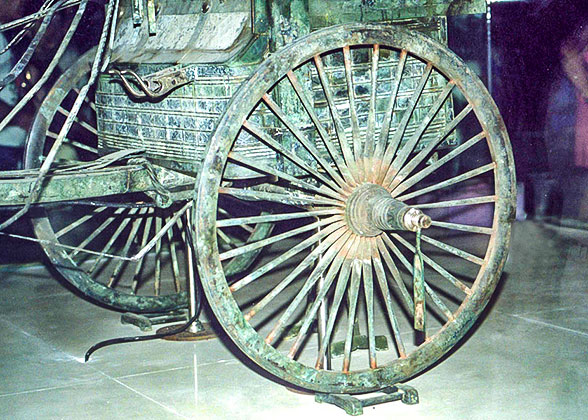 | | The Wheels of the Chariot | |
Magnificent Colored Drawings
The two excavated chariots possess magnificent colored drawings to show their gorgeousness and magnificence. The chromatic decorations cleverly conceal the traces of patching, and they play an important role in delaying the oxidation of the bronze as well. The basic color is white, and blue and green are the common colors appearing on the bronze carriages. The eight white horses harnessed to the chariots have pink mouths and nostrils, and the drivers have blue-black hair, pink faces and long sky-blue robes.
 You may like: Stallions or mares are the war horses in the Terracotta Army?
You may like: Stallions or mares are the war horses in the Terracotta Army?
 Recommended Tours including the visit to Terra Cotta Warriors and Horses:
Recommended Tours including the visit to Terra Cotta Warriors and Horses:
Terracotta Warriors Tour: One-day to visit Terracotta Warriors and Horses and more
More Xi'an Tours
 Next: Qin Shi Huang Mausoleum
Next: Qin Shi Huang Mausoleum
- Last updated on Sep. 13, 2024 by Nancy He -
![]() You may like: Stallions or mares are the war horses in the Terracotta Army?
You may like: Stallions or mares are the war horses in the Terracotta Army?![]() Recommended Tours including the visit to Terra Cotta Warriors and Horses:
Recommended Tours including the visit to Terra Cotta Warriors and Horses:![]() Next: Qin Shi Huang Mausoleum
Next: Qin Shi Huang Mausoleum







